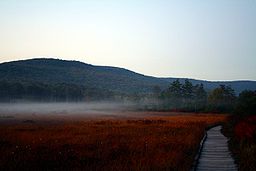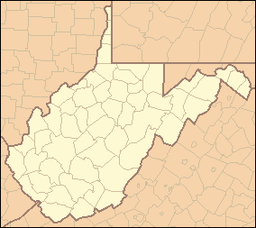- Cranberry Glades
-
Cranberry Glades Part of Monongahela National Forest National Natural Landmark Fog over Cranberry Glades boardwalkCountry United States State West Virginia County Pocahontas Elevation 3,400 ft (1,036.3 m) Coordinates 38°12′11″N 80°15′59″W / 38.20306°N 80.26639°W Area 750 acres (303.5 ha) [1] Management Monongahela National Forest Owner USDA Forest Service Easiest access drive-up via  FR 102
FR 102Topo map USGS Lobelia Nearest city Hillsboro, West Virginia Website: Cranberry Glades Botanical Area Cranberry Glades — also known simply as The Glades — are a cluster of five small, boreal-type bogs in southwestern Pocahontas County, West Virginia, USA. This area, high in the Allegheny Mountains at about 3,400 feet (1,000 m), is protected as the Cranberry Glades Botanical Area, part of the Monongahela National Forest. This site is the headwaters of the Cranberry River, a popular trout stream, and is adjacent to the nearly 50,000-acre (200 km2) Cranberry Wilderness.
The Glades are a 750-acre (3.0 km2)[1] grouping of peat bogs resembling some Canadian bogs. The gladed land is highly acidic and supports plants commonly found at higher latitudes, including cranberries, sphagnum moss, skunk cabbage, and two carnivorous plants (purple pitcher plant, sundew). The Glades serve as the southernmost home of many of the plant species found there.
The Glades have been the subject of much scientific study, especially during the 1930s, '40s and '50s. Professor Maurice Brooks conducted studies in 1930, 1934, and 1945. The work of Strausbaugh (1934), Darlington (1943), and Core (1955) followed.
In 1974, the Cranberry Glades Botanical Area was designated a National Natural Landmark.
Contents
Geography and geology
The natural history of the Glades has been traced back at least 12,200 years. Apparently, a forest of conifer-northern hardwoods replaced tundra with the end of the last Ice Age. Over time the Glades formed into what it is today. Now, most of the bog is underlain by peat that is up to 10 feet (3.0 m) thick. Under the peat is a layer of algal ooze and the ooze by marl. Since a limestone source in the surrounding rocks is indicated, an ample source appears to be present in the underlying Hinton Formation, a circumstance that also has significant implications for the Glades' flora.
The area is not entirely a glade, but a bog or wetland covered with all sorts of decaying vegetation. The peat and decaying organic matter is more than ten feet thick under the dense plant cover. The ground is not as much as quicksand or swampy, but spongy. It is in a high valley, about 3,300 to 3,400 feet (1,005 to 1,036 meters) above sea level, surrounded by the Cranberry, Kennison, and Black Mountains.
Five separate glades were identified and named in 1911[2] — Big Glade (59 acres), Flag Glade (28 acres), Long Glade (20 acres), Round Glade (8 acres) and Little Glade (1 acre). The smallest, Little Glade, has since grown over and is no longer recognizable.[3]
Darlington's studies showed that the Glades were formed by easily eroding rocks in the basin and more resistant rock at its lower end. This effectively prevented down-cutting and maintained a low gradient in the valley. This resulted in an elevation of 3,400 ft (1,000 m) at the upper end and 3,350 ft (1,020 m) at the back, eliminating the possibility of origin by water impoundment.
The water from the Glades drains to form the headwaters of the Cranberry River, a popular trout stream joined by the Yew and Charles Creeks. It starts at about 4,600 feet (1,400 m) above the sea, and then it meanders through the glades and recedes through a narrow gap between Kennison and Black Mountains. It then joins the Gauley River 25 miles (40 km) down the mountains at about 1,920 feet (590 m) above sea level.
Ecology
Flora
Many of the plants found in the Glades resemble those in the northern region of North America. They are descendants of seeds that took root over ten thousand years ago before the last glacial retreat. Among these are two unusual species of carnivorous plants that thrive in the area — the purple pitcher plant and native sundew. They evolved carnivorous habits because of the scarce root food in the spongy soil. Two very rare boreal plants — bog rosemary and buckbean — also live in the 59-acre (240,000 m2) Big Glade. Much of the area provides a home for many species of mosses. These include a cover of sphagnum moss, bird-wheat moss, bog moss and reindeer lichen. Hummocks of these plants reach a height of 3 feet (0.91 m). Over top of these grow prostrate cranberry vines that bloom nice pink flowers in the summer and a bunch of fruits in late September.
- Trees:
The bog forest is composed mainly of red spruce, eastern (or Canada) hemlock, and yellow birch. Because of the cool climate of the Glades, the amount of canopy tree species is not great. Red maple, black ash and pitch pine are also not uncommon. The upland forests immediately surrounding the wetlands are dominated by these same species, but also include American beech, sugar maple, black cherry, American basswood, white ash, yellow buckeye, black birch, cucumber tree, Fraser magnolia, and white oak. In addition, there are also many more understory trees and shrubs.
- Shrubs:
The Glades' shrubs, unlike their tree population, are very diverse. This is in part a consequence of the presence of shrub swamps, forest habitats, and glades. The dominant species is the speckled alder. Also common are pipestem, glade St. Johns-wort, great rhododendron, hobblebush, smooth arrowwood, roughish arrowwood, wild raisin, ninebark, alternate-leaved dogwood, bunchberry, winterberry holly, mountain holly, and the Appalachian endemic longstalked holly, swamp rose and many more. Bog rosemary is at its southernmost limit of distribution. The oblongfruited serviceberry is a rare northern shrub, isolated from the rest of its species here. More than ten of these shrubs have markedly northern distributions and at least three are at their farthest southern limits. The Canada yew is a special evergreen shrub that was once so common in the area, that nearby Yew Creek and Yew Mountains are named after it. Browsing deer have reduced its numbers to such an extent that it is found only in scattered locations throughout its Central Appalachian range, including here.
- Herbs:
Rare northern herbs also populate the area: oak fern, pod grass, Canada mayflower, mountain bindweed, marsh marigold, goldthread, swamp saxifrage, white wood sorrel, northern white violet, Jacob's ladder and buckbean. Grasses and sedges found here include blue joint, drooping wood reed grass, millet grass, rattlesnake mannagrass, interior sedge, and Fraser's sedge. Wild lilies in the Glades include yellow clintonia and white hellebore. Several species of orchids also grow here, such as the rose pogonia, lesser rattlesnake plantain, northern coralroot, and grass-pink orchid that are in full bloom in July.
Fauna
Many animals that live in the Glades are at their southernmost breeding grounds, including birds such as the Swainson’s and hermit thrushes, Nashville and mourning warblers, and purple finches. Other, less exotic, birds like ravens and hawks are common. Other familiar animals including whitetail deer inhabit the Glades. Black bears have been seen in the skunk cabbage growing along the boardwalk. In the evening, you have a good chance of hearing beavers working; they are mostly inactive during the day. It is hard to see the beavers because of little light, and they are dark colored. They also reside submerged or are building their homes.
Weather
Like many of the adjoining areas high in the Alleghenies, Cranberry Glades is known for frequent weather changes. Generally speaking, the area is cool and wet, comparable to the climates of New England and Canada. The higher mountains surrounding the Glades form a bowl, draining their cool air downhill to the Glades.
Due to the high elevation, the potential for frost exists year-round at Cranberry Glades. In some years, the frost-free period has been as short as 81 days.[citation needed] Still, the average summer high is in roughly 74 °F-82 °F (23 °C-28 °C).[4] Mid-winter temperatures record as low as −26 °F (−32 °C),[4] and the area often sees heavy snow.
Recreation
Today, Cranberry Glades serves as a major tourism stop along the Highland Scenic Highway corridor. Adjacent to the Glades is the Cranberry Mountain Nature Center providing interpretive services. Within the Glades area itself, Monongahela National Forest has constructed a 0.5-mile (0.80 km) boardwalk that traverses the edge of some bogs and a small wooded section. The entire Glades area itself is traversed by Cowpasture Trail, a 6.0-mile (9.7 km) improved hiking path that serves as the border between the Cranberry Glades Botanical Area and the much larger Cranberry Wilderness. Due to the ecologically-sensitive nature of the area, visitors are not permitted to leave these developed paths within the Glades.
See also
- Cranberry Wilderness
- Cranberry River
- List of National Natural Landmarks
- List of National Natural Landmarks in West Virginia
References
- ^ a b "Cranberry Glades Botanical Area". Monongahela National Forest. http://www.fs.fed.us/r9/mnf/sp/cranberry_glades.html. Retrieved 2008-11-03.
- ^ Brooks, A.B. (1911), "Forestry and Wood Industries", West Virginia Geological Survey, 5:247-249.
- ^ Edens, David L. (1977), "Cranberry Glades, A Unique Series of Boreal Bogs in the Appalachian Mountains of West Virginia"; In: Adkins, Howard G., Steve Ewing and Chester E. Zimolzak (Editors), West Virginia and Appalachia: Selected Readings, The West Virginia Council for Geographic Education, Dubuque, Iowa: Kendall/Hunt Publishing Company, pp. 19-37.
- ^ a b "Average Weather for Hillsboro, WV". The Weather Channel. http://www.weather.com/weather/wxclimatology/monthly/graph/USWV0349?from=36hr_bottomnav_undeclared. Retrieved 2008-11-03.
External links
- Monongahela National Forest: Cranberry Glades page
- Monongahela National Forest: Cranberry Mountain Nature Center Webpage
- West Virginia Division of Natural Resources: Cranberry Glades page
- National Park Service: NNL Webpage on the Glades
- Eastern Panhandle Native Plant Society: Cranberry Glades Plant List (2001)
National Recreation Areas Wilderness Areas Big Draft Wilderness • Cranberry Wilderness • Dolly Sods Wilderness • Laurel Fork North Wilderness • Laurel Fork South Wilderness • Otter Creek Wilderness • Roaring Plains West Wilderness • Spice Run Wilderness
Observation Towers Lakes Lake Sherwood • Spruce Knob Lake • Summit Lake
Mountains and Summits Allegheny Front • Allegheny Mountain • Back Allegheny Mountain • Backbone Mountain • Barton Knob • Bickle Knob • Champe Rocks • Cheat Mountain • Gaudineer Knob • Mount Porte Crayon • North Fork Mountain • River Knobs • Seneca Rocks • Shavers Mountain • Spruce Knob • Spruce Mountain
Other Major Areas Blackwater Canyon • Camp Allegheny • Bear Rocks Preserve • Canaan Valley • Cheat Summit Fort • Cranberry Glades • Fernow Experimental Forest • Gaudineer Scenic Area • Germany Valley • Highland Scenic Highway • Sinks of Gandy • Smoke Hole Canyon
Rivers and Creeks US Forest Service Categories:- Bogs of West Virginia
- Botanical gardens in West Virginia
- Monongahela National Forest
- Protected areas of Pocahontas County, West Virginia
- Wetlands of West Virginia
- National Natural Landmarks in West Virginia
Wikimedia Foundation. 2010.



